Today, the keeping of elephants in human care is under scrutiny in zoos and animal facilities all over the world. Information, research and education are raising questions about how these unique mammals have been kept historically and challenging the motives behind their treatment at the hands of humans. Indeed, the days of ‘menageries’ – when people transported and displayed exotic animals simply because they could – are quickly becoming consigned to the past, as the spotlight shifts towards a planet under immense environmental stress, where natural habitats are becoming scarcer by the day.
Much like the recent re-assessment of cetaceans in human care, the standards of wellness for elephants in zoos, circuses, and animal facilities all around the world are often inadequate for these complex, biologically unique animals. Elephants in their natural habitat live a nomadic lifestyle, rich in familial relationships and multi-generational interaction. Their lifestyle allows them to travel great distances, to feed continuously and to carry out their natural life cycle surrounded by others. All too often, these natural patterns of behaviour have been overlooked and elephants have historically been kept in restricted, badly designed enclosures that often negatively impact their psychological and physical health.
In these shifting times, there is a lot of pressure on zoos and facilities that house elephants to evaluate the standards of care they offer and to make decisions about the future of their own animals, as well as the species as a whole.
There is no quick fix to the hugely varied models of care currently in place in zoos around the world. Timely, adequate changes can only be made if zoos work closely together to improve the overall standards of wellness for elephants in human care. There must be a long-term vision for all elephants – those who have survived the inadequacies of the past and those who will be part of a new future.
In Global Elephant Care, we believe that it is both possible and advisable to assess each elephant currently in human care against a number of criteria – i.e. intentional locomotion, activity, access to multiple feeding options, opportunities to express biological imperatives (browsing, digging, swimming etc.). Familial social groups or bull facilities must be prioritized so that we can safely house multiple generations of elephants together. Space is perhaps the most critical factor, and, in an ideal world, every facility would have the topography and technology to allow their elephants to travel a minimum of 10-15 kilometres a day.
Global Elephant Care can offer high levels of expertise on a wide range of elephant care needs. We work with a network of international experts to provide the very highest standards of care for zoo elephants.
The AZA Standards for Elephant Management and Care (Revised May 2020) states that “All elephant care professionals at AZA facilities with elephants must not share the same unrestricted space with elephants, except for certain, limited exceptions”. The EAZA Position Statement on the Evolution of Elephant Management Systems at Member Zoos was approved by the EAZA Elephant Taxon Advisory Group on 4 July 2019. This statement declares that the EAZA Elephant Taxon Advisory Group has decided to adopt protected contact (PC) management of elephants as the sole management system for both species. The TAG recognises the challenges that this poses and has therefore made it a requirement of all EAZA members with elephants to adopt a protected contact management system by 1 January 2030 at the latest.
These standards might seem daunting for many and unachievable for others. I am passionate about offering independent, supportive advice for facilities who are hoping to improve the standards of wellness they offer for elephants or who are re-assessing the consequences of keeping elephants within these new standards. I fully understand the complexities of running an animal facility and know that there is no “one-size-fits-all” solution to the challenges of keeping elephants in human care. I like to offer the same holistic approach to my clients as I do to the care of their elephants and offer tailor-made support to each individual zoo or animal facility.
One of the most inspiring and motivating aspects of my role as a consultant is to see, time and time again, that small changes can have big effects on the elephants we keep in human care. The very first step in the consultancy that I offer is an assessment of your elephant programme. This stage is very much a two-way communication process that explores the systems that are already in place and opens discussion about the options that are available to streamline, improve or develop your programme. I can look closely at any individual part of your programme that you would like addressed, but I generally recommend a full assessment, so that you can maximize the use of my time and expertise while I am on-site in your zoo or animal facility. I have listed below the areas that could be covered during my visit, but I am always happy to address any new queries or concerns that arise during my visit.
Safety
•Health and safety protocols
•Risk assessments
•Staff safety awareness
•Animal safety
•Emergency protocols
•Areas of concern
Facility
•Space and design
•Capacity
•Training areas
•Rotational options
•Substrate
•Feeding opportunities
•Technological support
•Expansion
Husbandry
•Veterinary and Elephant Care Team access
•Nutrition and health
•Reproductive health
•Hygiene and cleaning
•Medical administration
•Emergency protocols
•Food storage and waste removal
•Restraint options
•Transportation
Footcare
•Foot access
•Tools and support
•Knowledge of elephant physiology
•Individual footcare assessment
•Maintenance care
Elephants
•Individual wellness assessment
•Behavioural assessment
•Life-span planning
•Breeding
Team
•Communication
•Training
•Elephant Care Team grading
•Development
Transportation
•Crate design and specification
•Crate training programme
•Welfare during travel
•Introductions and consistency of care
Education
•Conservation and key messages
•Signage
•Presentations
•Research

